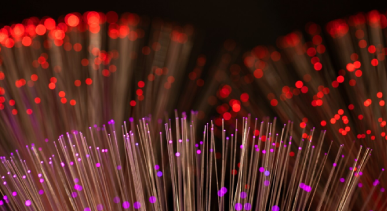The optical fiber reaches a new peak with a world record of 301 terabits per second!”

Engineers from Aston University have made a breakthrough by transmitting data at a speed 4.5 million times faster than conventional broadband. In collaboration with experts from the National Institute of Information and Communications Technology (NICT) in Japan and Nokia Bell Labs in the United States, researchers at Aston in Great Britain have achieved a remarkable breakthrough in the field of internet data transmission. Their technology is based on the use of wavelength bands previously untapped in fiber optic systems, thus setting a new world record for data transfer speed.
The result is not only impressive but also very promising, as they have managed to reach a speed of 301 terabits per second (Tbps). To give an idea of this performance, it represents a speed 4.5 million times higher than the average broadband available in most households. It's the equivalent of downloading an entire movie in a few hundredths of a second!
They exploited wavelength bands that had been untapped until now.
In its latest report, Ofcom indicates that the average download speeds for home broadband continued to grow. In March 2023, the average download speed was 69.4 Mbit/s, recording a 17% increase over the year. Ofcom is the English equivalent of ANRT in Morocco.
What makes this work even more remarkable is that the engineers exploited the existing infrastructure by simply increasing its capacity. Given that copper cables cannot support such speeds, the researchers opened new wavelength bands in the electromagnetic spectrum.
Ian Phillips, one of the lead researchers, explains: "In addition to the commercially available C and L bands, we used two additional spectral bands called E band and S band. Such bands are traditionally not needed as the C and L bands are sufficient to provide the required capacity to meet consumer needs."
The researchers also implemented amplifiers to ensure signal robustness over long distances.
In the case of fiber optics, the different wavelength bands equate to different colors of light transmitted along the fiber. To achieve these advancements, the researchers developed new devices such as optical amplifiers and optical gain equalizers.
Dr. Phillips explains: "In recent years, Aston University has developed optical amplifiers operating in the E band, which is adjacent to the C band in the electromagnetic spectrum but is about three times wider. Before the development of our device, no one was able to properly emulate E band channels in a controlled manner."
A "more ecologically sound" solution
According to Ian Philips and his colleague Wladek Forysiak, this approach has a dual benefit. On one hand, it offers a practical solution by increasing the speed of data transmission. On the other hand, it is economical and ecological, as it involves no changes to the existing infrastructure.
In their study published by the Institution of Engineering and Technology (IET), they state: "It is also a 'greener solution' than deploying newer fibers and cables, as it makes more use of the existing deployed fiber network, thus increasing its capacity to carry data and extending its useful life and commercial value."




